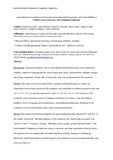| dc.contributor.author | Leader, Geraldine | |
| dc.contributor.author | Whelan, Sally | |
| dc.contributor.author | Ni Chonaill, Niamh | |
| dc.contributor.author | Coyne, Rory | |
| dc.contributor.author | Tones, Megan | |
| dc.contributor.author | Heussler, Honey | |
| dc.contributor.author | Bellgard, Matthew | |
| dc.contributor.author | Mannion, Arlene | |
| dc.date.accessioned | 2022-09-07T12:48:20Z | |
| dc.date.available | 2022-09-07T12:48:20Z | |
| dc.date.issued | 2022-09-02 | |
| dc.identifier.citation | Leader, Geraldine, Whelan, Sally, Ni Chonaill, Niamh, Coyne, Rory, Tones, Megan, Heussler, Honey, Bellgard, Matthew, Mannion, Arlene. (2022). Association between early and current gastro-intestinal symptoms and co-morbidities in children and adolescents with Angelman syndrome. Journal of Intellectual Disability Research, doi: https://doi.org/10.1111/jir.12975 | en_IE |
| dc.identifier.issn | 1365-2788 | |
| dc.identifier.uri | http://hdl.handle.net/10379/17347 | |
| dc.description.abstract | Background
Angelman syndrome (AS) is a neurogenetic disorder that causes severe intellectual disability, expressive language deficits, motor impairment, ataxia, sleep problems, epileptic seizures and a happy disposition. People with AS frequently experience gastrointestinal (GI) symptoms.
Method
This study used data from the Global Angelman Syndrome Registry to explore the relationship between early and current GI symptoms and co-morbidity in children and adolescents with AS (n = 173). Two groups that experienced a high (n = 91) and a low (n = 82) frequency of GI symptoms were examined in relation to feeding and GI history in infancy, sleep and toileting problems, levels of language and communication and challenging behaviours. Predictors of GI symptoms were then investigated using a series of logistic regressions.
Results
This analysis found that constipation and gastroesophageal reflux affected 84% and 64%, of the sample, respectively. The high frequency of GI symptoms were significantly associated with: ‘refusal to nurse’, ‘vomiting’, ‘arching’, ‘difficulty gaining weight’, gastroesophageal reflux, ‘solid food transition’, frequency of night-time urinary continence and sleep hyperhidrosis during infancy. GI symptoms were not significantly associated with sleep, toileting, language or challenging behaviours. Significant predictors of high frequency GI symptoms were gastroesophageal reflux and sleep hyperhidrosis.
Conclusions
Future research needs to investigate the association between AS and GI co-morbidity in adults with AS. | en_IE |
| dc.format | application/pdf | en_IE |
| dc.language.iso | en | en_IE |
| dc.publisher | Wiley | en_IE |
| dc.relation.ispartof | Journal Of Intellectual Disability Research | en |
| dc.rights | CC BY-NC-ND 3.0 IE | |
| dc.rights.uri | https://creativecommons.org/licenses/by-nc-nd/3.0/ie/ | |
| dc.subject | Angelman Syndrome | en_IE |
| dc.subject | Comorbidity | en_IE |
| dc.subject | Gastrointestinal Symptoms | en_IE |
| dc.subject | Global Angelman Syndrome Registry | en_IE |
| dc.title | Association between early and current gastrointestinal symptoms and comorbidities in children and adolescents with Angelman syndrome | en_IE |
| dc.type | Article | en_IE |
| dc.date.updated | 2022-09-07T08:56:26Z | |
| dc.identifier.doi | 10.1111/jir.12975 | |
| dc.local.publishedsource | https://doi.org/10.1111/jir.12975 | en_IE |
| dc.description.peer-reviewed | peer-reviewed | |
| dc.internal.rssid | 28982019 | |
| dc.local.contact | Geraldine Leader, Dept. Of Psychology, Room 203, St. Anthony'S, Nui Galway. 3434 Email: geraldine.leader@nuigalway.ie | |
| dc.local.copyrightchecked | Yes | |
| dc.local.version | ACCEPTED | |
| nui.item.downloads | 42 | |


